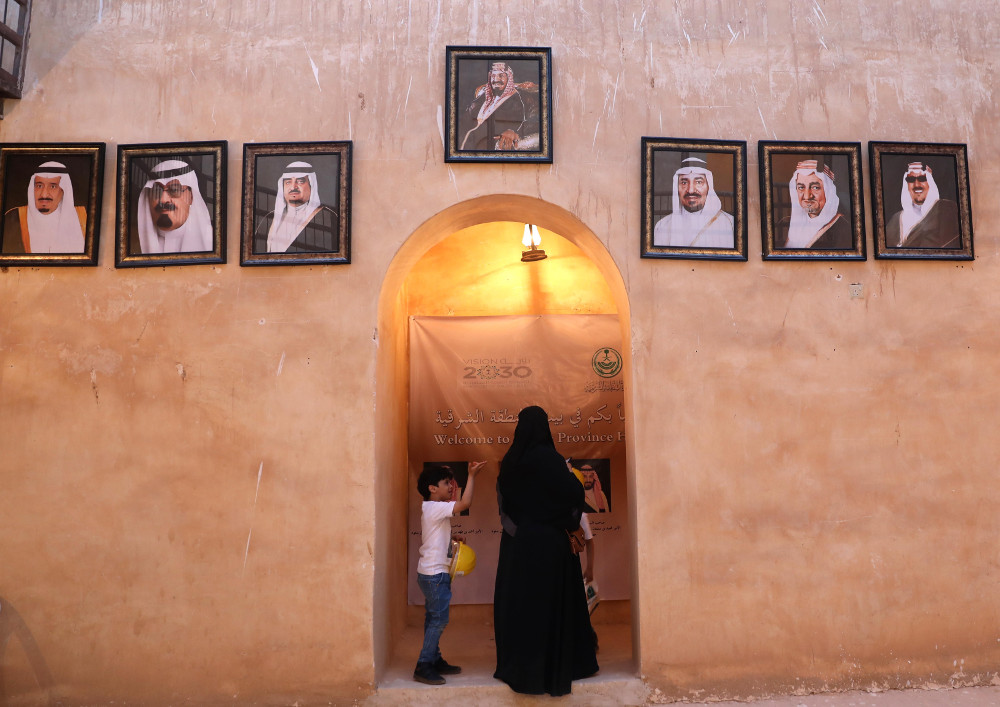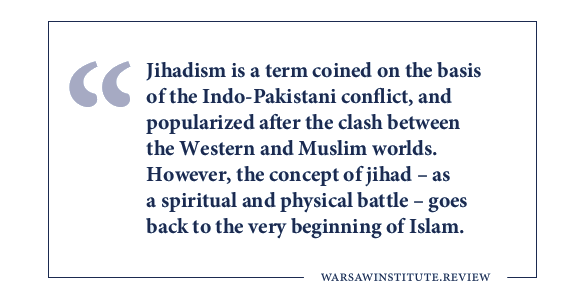THE WARSAW INSTITUTE REVIEW
Date: 12 March 2018 Author: Marcin Orłowski
The Kingdom of Saudi Arabia and the Future of Jihadism
Much is said about the reforms to be initiated by Crown Prince Mohammad bin Salman.

Nevertheless, there is a risk that despite the likely mixed success of many economic and social projects, the successor to the throne may not be able to meet societal expectations. Signals of this are already visible in the Saudi Vision 2030 plan. This report proposes, for example, the privatization of education, an area that has been dominated by the clerics. Many of them have not hid their extremism and successfully recruited jihadists. Will the change from state to private patronage however turn out to be disastrous?
Popularly, jihadism is considered to be linked with Western interference, but it turns out that it is not the main cause of its formation. It is the result of defects in the economic, social and territorial structures of the Middle East. Jihadism is also not divided, instead only dispersed. Saudi Arabia, despite its financial wealth, is one of the countries most at risk of jihadism. The wealthiest elites can afford to have relaxed moral standards after all. From their point of view, the jihadists who often threatened the Saudi Arabian regime are (speaking in terms familiar to us) nothing but deistic communists proclaiming liberation theology.
Jihadism – do we really understand it well?
The beginnings of Islamism and jihadism date back to the 1920s and 1960s, respectively, and the date of the appearance of global jihadism is considered 1979. This is due to the following criteria:
- the founding of the pan-Islamizing (communizing) Muslim Brotherhood organization in Egypt in 1928;
- popularization of Muslim thought and schools sanctioning violence in the 1960s;
- the engagement of Muslim fighters in the war in Afghanistan in 1979.
It has been popularly accepted that global jihadism in the last four decades has spawned four waves. The first was created as a result of the Soviet invasion of Afghanistan (1979) and assumed the creation of an international group of Muslim fighters that would liberate Muslim territories from occupation. This goal was to be carried out by the Afghan Services Bureau (Maktab al-Khidamat), which was continued by Al-Qaeda. The second came after the fall of the Islamist revolts in Algeria and Egypt (circa 1997), and its purpose was to expel the United States from the Middle East, where they supported the rule of “apostates.” The third was after the fall of the “emirate” of Al-Qaeda in Afghanistan (2001), i.e. the loss of a “safe haven” for extremists. The fourth was caused by the U.S. invasion of Iraq (2003) and the takeover of power by Shiites in that country and the destabilization of Syria (2011).
There are five errors in this perception of jihadism however. The first problem is the belief in the actual existence of these waves.

Given the natural tendency of empires to break apart, battles for supremacy between groups and state entities, as well as rebellions, that today we would call terroristic or jihadist, have plagued the Muslim world and surrounding regions practically from the moment Islam emerged. Looking at jihadism as a phenomenon of the past two-hundred years at most, is a result of the perspective of colonial nations (primarily France and Great Britain) and the United States. It also connects with the Indian perspective, a product of the territorial conflict with Pakistan. A common feature of these views is jihadism’s opposition to the order imposed in the region either peacefully or through force. European countries could recognize however, if they were to be convinced that it is appropriate, that they are dealing with jihadism from the first moment of an armed clash with Muslims. Islam, like every religion, proclaims peace; but it does not exclude the possibility of fighting, if only in the name of peace and the interests of the community. As long as the goals of jihadists are not reached, their struggle is endless. Jihadists assume that their physical and spiritual struggle is as permanent as the revolution that Trotsky envisioned.
The second mistake is assuming that jihadism is an intermittent phenomenon that moves by stages. As a strategic goal, jihadists want to restore the unity of lawful power over the Muslim community. This perspective is far-reaching, probably exceeding the life spans of many generations and therefore requiring steady action. In addition, it is an unclear vision that is simplified in many ways, and therefore utopian to a large extent. Jihadism is thus a permanent and centuries-old phenomenon, benefiting from the interests and conflicts of regional countries and the foreign powers present in the Middle East.
The third mistake in the perception of jihadism is limiting it to Sunni and non-national groups. Both Sunnis and Shiites can be jihadists, and the pan-Islamic ideologies of jihadist organizations are often a cover for the national interests of individual countries in the region. An example is the anti-Israeli Hamas, which (although Sunni) is sponsored not only by Sunni states, but also by the Shiite Islamic Republic of Iran. In addition, the Sunni Al-Qaeda and Muslim Brotherhood are carrying out transnational activities, however in obtaining resources, including recruits and financing, they primarily make use of local, national conflicts. The Shiite Hezbollah works no differently. In this way, the local branches of the parent organizations are transformed into autonomous, local (tribal) national movements, such as ISIS or Hamas. In the same way, the Islamic Revolutionary Guard Corps of Iran created, among others, Hezbollah in Lebanon in the 1980s.
On the other hand, organizations at the local or national level are often transformed into supranational ones, for example: inspired by the Muslim Brotherhood, the Afghan Services Bureau transformed into Al-Qaeda; Al-Qaeda in Iraq into ISIS; the Egyptian Muslim Brotherhood became a supranational organization in the 20th century and currently seem to have open support from Turkey; Lebanese Hezbollah found imitators (also supported by Iran) in Iraq, of whom there will probably be no shortage of in Syria after the defeat of ISIS. At present, there is speculation about the possible (if only temporary) combining of forces of the so-called Islamic State and Al-Qaeda, as well as Hamas and Hezbollah. Although both fronts, as far as they crystallize, seem to have many discrepancies between them due to the fact that they are anchored in the local structures of various countries of the region, their strategic, long-term goals are basically identical.
The fourth, perhaps the most important mistake, is to perceive all currents of jihadism as being divided, and unable to merge into one stream. This hypothesis is undermined by the so-called Arab Spring, which with the appropriate demographic and macro-political conditions could transform into a Muslim Spring.
The fifth, and the most critical error, is the perception of jihadism as exclusively correlated with the intervention of Western states into North Africa and the Middle East. Defects in the economic and social structures at the foundation of authoritarian rule in the region are in themselves a sufficient generator of frustration and polarization, which in turn finds an outlet in jihadism.
Jihadism is therefore a methodically mixed (armed and peaceful) anarcho-revolutionary and communizing movement (assuming the achievement of complete solidarity of the Ummah, i.e. the community of the faithful, encompassing the peoples of the book, including Christians). It may pose a threat to any state and society that it considers to be apostates. It is enough to see that the “jihad of liberation” is but another form of the more culturally familiar “liberation theology”.
The Threat of Jihadism in Saudi Arabia
If we look at the present situation of the Kingdom of Saudi Arabia, we can see that King Salman and Crown Prince Mohammad bin Salman are clearly anxious about jihadist activity. There are several reasons for such concerns.

The first are the circumstances in which Mohammad bin Salman came to power. Thus far, succession took place between the sons of Ibn Saud (Abdulaziz). However this time it came with a generational change – Mohammad is Ibn Saud’s grandson and exceptionally young at thirty-two. Claimants to the throne are numerous, as Ibn Saud fathered many children in his life. This means that Mohammad could expect resistance to the legitimacy of his future power. However, a generational change at the highest level of power was anticipated in the 1990s, so it should not be too difficult for the Saudis. Even appropriate institutional arrangements were made (the Allegiance Council composed of electors to choose successors to the throne). Therefore, it is difficult to avoid the impression that, for example, the November arrests of many prominent family members and other former confidants on charges of corruption was more of a show of force than a real consolidation of power in the hands of the young prince. However, if Mohammad actually nominates a prince and viceroy who are not accepted by his opponents, he will have cause for concern. Opponents can not only shorten Mohammad’s reign without having to deprive him of the throne, but can also force him to make concessions by taking advantage of societal dissatisfaction.
The second reason for concern is precisely this social dissatisfaction, which is a very real threat to Saudi Arabia. To understand the scale of the threat, some wider socio-economic context is necessary. It is only after understanding this that one can see how exposed the Kingdom is to social tensions and how they are forced to forcibly suppress them. This context will also explain the modest and gradual reforms over the course of many years. In addition, it is worth mentioning that each of these changes was introduced in order that the Kingdom’s authoritarian royal power could survive as long as possible. The population of Saudi Arabia has doubled in the last twenty-seven years. Currently, sixty percent of Saudis are under thirty years old. It is almost exactly the same amount as the entire non-Saudi segment of the Kingdom’s inhabitants. Officially, unemployment in Saudi Arabia is less than thirteen percent, but it is speculated that unofficially it is double that. Population growth intersected with the fall in oil prices and led to the need to cut subsidies, which are the main benefit for public sector employees. Positions in the state sector are occupied primarily by Saudis since they face employment difficulties in the expatriate-dominated private sector.
Due to the increasing number of graduates of domestic and foreign universities, steps were taken to “Saudize”, that is, to expel expatriates for the benefit of native citizens. Therefore, by the end of 2020, all expatriates working in the public sector (about 70,000 people) are to be laid off. The “Saudization” process touches on two sensitive issues: the threats of corruption and nepotism. Although “Saudization” will not negate these threats, it postpones the need to reduce benefits to the public sector. Forcing excessive cuts in public benefits is risky and the steps already taken have been insufficient. Therefore, the next pressures that Saudi society will face are fiscal solutions. Last year a selective tax on goods and a residence tax for expatriates was introduced, and from 2018, a five percent VAT will be introduced. Mohammad bin Salman’s anti-corruption efforts were welcomed by both the public and the clerics because they represented a solidarity gesture of the justice of elites with society. However, a high percentage of young people in the population of Saudi Arabia means the state has great difficulty meeting the requirements and needs of its citizens. This has been the condition for many years. This means that despite reforms, social polarization exists and will continue to exist until the age pyramid of the population stabilizes. This is what caused – and will cause – such high attraction to extremist groups in the Kingdom. Therefore, it should not be assumed that there will be fewer terrorist incidents there in the future. It is highly likely that there will be more.
The third reason is that the introduced reforms aim to build an industrial base to ensure economic growth while reducing dependence on oil production. This objective is part of the package of twelve reform programs embodied in the Saudi Vision 2030 (V30) plan. According to V30, reforms are to be introduced gradually over five-year periods. Due to historical analogies, the V30 is allusively compared to the reforms of Deng Xiaoping in China and in the Soviet Union, and those of the White Revolution of the last Shah of Iran. A general similarity between the V30 and other reform strategies exists, because all are a contract between the elites and society. Although speculation has been primarily about economic reforms, the social dimension is equally important. The reforms foreseen in the V30 are also supposed to build a base of social support, but at this moment they do not assume societal control over the elites. In this regard, the main intermediaries (apart from clan relations) are still the clerics, who in exchange for gestures by Mohammad bin Salman to curb elite corruption and increase social justice, support the liberalization of social mores, though they are reluctant to do so. It is worth mentioning here that the clerics are not against social freedoms simply for religious reasons but as a matter of image. Only the elite can afford (financially) greater social freedoms. That is why Mohammad bin Salman’s actions remain – on a national scale – only gestures that do not directly translate into a decrease in corruption overall in the Kingdom.
More importantly, the degree of success of the reforms and, above all, the scale of providing jobs, a dignified life and opportunities for leisure time, will determine real public support. The experience of Chinese, Soviet and the Shah’s reforms, indicate that industrial development and modernization does not go according to plan while there are difficulties in meeting high social expectations. Therefore, building an industrial base unrelated to energy will be a big challenge, also due to the threat of corruption and the incompetence of personnel, who have already wasted some of the funds they have received. In all cases of such wide reforms, the elite’s adaptability was crucial (the Saud dynasty can be considered a party, given the size and number of familial relationships) and the degree of their internal solidarity. For this reason, although in recent years in Saudi Arabia there was no shortage of gestures to liberalize public life, the Sauds cannot abandon the strong support of the clerics.
The fourth reason is the heritage of Sunni puritanism engrained into the Saudi nation, known as Wahhabism. Saudi Arabia was created thanks to Wahhabism, which does what the authorities in Riyadh cannot do – it spreads itself in various forms. More than once in the history of the Kingdom have opponents of various reforms revolted (e.g. student protests in 1956, the uprising in Buraidah in 1994). In addition, despite the many tensions with the religious establishment, the Sauds are responsible not only for internal social mood, but externally in other Muslim countries, especially Sunni ones. The reason for this is obvious – they are the historical center of the Islamic world. They cannot tolerate any internal or external enemy who would accuse them of submitting to foreign powers or apostasy. The first split of the Saud dynasty with a group of militant puritan Wahhabis, called the Brothers, appeared in the 1920s. At that time, the goals and political interests of King Ibn Saud were at odds with those of the Brothers who wanted the territorial expansion of the Kingdom. Making themselves known through arbitrary assaults on neighboring countries, they began to threaten the Saud dynasty. In the face of such danger, the King made a decision to obtain a legal statement (fatwa) from the clerics to settle the dispute. Having received a positive opinion of the King’s judgment, Ibn Saud decided to purge the ranks of his troops of Brothers. However, the Brothers made themselves known again fifty years later, when in 1979 they occupied the Grand Mosque in Mecca. The occupation lasted two weeks and was a response to the apostasy of the Saudi authorities and their submission to foreign forces. These are the same accusations as from the time of the first split in Islam. Similar accusations could arise again if the foreign policy of the Kingdom will be too submissive to external pressures, and the social contract will be considered unfair.
After 1979, the number of attacks did not increase – the Kingdom responded with, among other things, restrictive social norms with the support of the clerics. However, in the 1990s, attacks were directed against American, British and French troops present in Saudi Arabia. Jihadist organizations have recognized that the power of apostates in Muslim countries can only be overthrown if their ties with Western countries, and especially to the U.S., are severed – the tragic crowning of which were the attacks on September 11, 2001. The intervention of the U.S.-led coalition in Afghanistan and Iraq resulted in a dramatic increase in the number of terrorist attacks in Saudi Arabia. The years 2004–2005 were particularly intense, when Abdullah, who had in fact served as the de facto king since 1995 (when King Fahd became unable to rule for health reasons), formally took power.
Although subsequent years were calmer, the emergence of the Islamic State in Iraq and Syria and the intensification of the conflict on the Sunni-Shiite axis caused a significant number of attacks in the entire Kingdom. The main target of these attacks, however, were areas inhabited by Shiites or nearby communities (e.g. provinces bordering Yemen). The distinction between perpetrators of attacks on specific organizations is important – the tension between Sunni and Shiite citizens is growing – but the fact of increasing jihadist activity in Saudi Arabia is more important. This activity is also connected with Saudi Arabia accusing Qatar of supporting the Muslim Brotherhood, who have been recognized by the authorities in Riyadh as a terrorist organization. They shared a fate similar to that of other “brotherhoods” in the history of this nation. The Kingdom’s conflict with Qatar turned out to be in part the implementation of the goals of the attacks of the 1990s, which led to the departure of U.S. troops from Saudi Arabia. There is an air base located in Qatar. The U.S. could abandon it if pressure increases.
Jihadist Evolution, Saudi Adaptation
The Saudi Muslim Brotherhood are still in Saudi Arabia despite the repercussions that fell on them for their actions against the monarchy in the 1990s and during the Arab Spring. They remain an important political asset in the Kingdom, and are also an inalienable foundation of the Saudi education system to this day. Although extremist groups and individuals (including Al-Qaeda and Osama bin Laden) often broke away from this organization, Riyadh, along with their loyal clerics, tries to co-opt the Brotherhood members. Considering the education privatization plan in the V30 plan, it can be assumed that King Salman does not intend to abandon the Brotherhood if they are loyal in return for the benefit of relative financial independence. This raises doubts, however, whether such activities will guarantee the pacifism of the Brothers. It seems more likely that there will be an attempt to take control of the Brotherhood by the elite, who are the potential donors on behalf of private education in the Kingdom.
The problem remains, however, that the reforms proposed in the V30 do not take political transformations into account. This means that in the case of unfavorable political and social circumstances the Brotherhood and jihadist groups may take advantage of the internal weakness of Saudi Arabia and demand political concessions. The opposition could then find support among some of the princes arrested in November this year, part of whom declared the legitimacy of democratizing the Kingdom’s form of government. Therefore, if the reforms provided in the V30 are not a success, proposals for real changes can be expected. Although this forecast may seem unrealistic at the moment, it does not have to be a distant one – conditions conducive to such a course of events may appear at a rapid pace. However, while the state of the Saudi economy is not threatened by crisis or implosion, and the authorities can offer their elites participation in privatization, a revolution will be forestalled. Possible attacks in the Kingdom will lead to reduced social expectations, and an increased need to ensure security in an authoritarian manner, at the expense of claims for new civil liberties and rights.
In addition, the co-opting and use of the Brotherhood and the traditional and loyal clerics in a joint way can serve the Saudis to compete for leadership in the region. In this respect, they have a common opponent: Shiite Iran and local organizations supported by it in the region. One of the Kingdom’s internal problems with external implications is that the oil-rich provinces are inhabited by Shiites, demanding equal treatment. Due to geographical location, these provinces cannot be effectively penetrated by pro-Iranian elements. However, the Sunni-Shiite discord has one common interest: defeating Israel. Although the vast majority of Muslims rejected the Islamic State because of its deeds, it effectively opened the way to the more moderating influence of Wahhabism and Saudi Arabia, such as in Iraq. The declared tightening of relations between Saudi Arabia and Israel against Iran may, however, reactively lead to a resurgence of communizing pan-Islamism. A radicalized inhabitant of the region (especially in Syria and Iraq) could ask, although the Islamic State was a degeneration, whether the true right vision of a larger Muslim state entity not buried by the Sunni-Shiite schism? The majority of the analytical works I have read for years assume the continuation of the Sunni-Shiite conflict as a certainty, but would an inter-factional alliance, despite divisions, be unrealistic? There are many processes that take place at such different speeds that it is impossible to see the moment of their coupling, especially during the lifespan of the individual. Therefore, the threat of jihadism in Saudi Arabia and the region – both Sunni and Shiite or combined – should be treated as continuous and probable.
Is Jihadist the Right Word?
Finally, we should consider whether it is more legitimate to interchangeably call terrorists in Europe: Islamists, terrorists, radicals, fundamentalists, jihadists or perhaps more precisely, anarcho-Muslims? From the perspective of jihadists, anarchy is only a transitional stage leading to a new order. The secular states of Europe, on the other hand, are attractive to many moderate and peaceful, though often conservative Muslims, who respect the secular supreme authority that ensures them security, prosperity and freedom of democratic participation. Therefore, the jihadists are also nothing but anarchists to them. Using a distinction between Muslims and anarcho-Muslims would allow a more effective fight against the generalizing perception of the Muslim community. In addition, ideologically, it would create a breakthrough for the conceptualization, crystallization and promotion of European Islam, which would be determined and motivated to coexist with the secular authorities and societies of Europe.
All texts published by the Warsaw Institute Foundation may be disseminated on the condition that their origin is credited. Images may not be used without permission.














